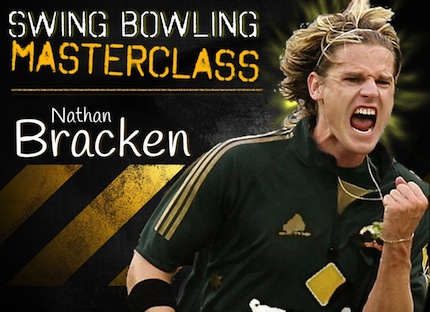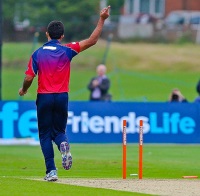This is a guest article from former professional bowler, and current Strength, Conditioning and Fast Bowling Coach Steffan Jones.
There is no doubt in my mind that most fast bowlers ignore the best training method that exists for improving pace.
Today we can break that trend.
I remember in 1999 I was was at the start of my career and was searching for that X-factor that would help me add pace onto my bowling. I was currently being clocked at 78mph. In county cricket that is neither here nor there.
I needed more.
Then I discovered a programme from Alan Pearson, owner of SAQ International. 12 week's of training that I had never tried before.
What happened next was unbelievable. I built myself into one of the quickest on the county circuit. I put on between 8-10mph of pace. I was clocked at 89.9mph at the Lords C&G Final in 2001 after two successive winters of "Arm Speed" training.
That's when I realised this stuff works. I knew when I went into strength and conditioning that it would become part of my method for developing other fast bowlers.
It's called Over-weight and Under-weight ball bowling (OU). And it's exactly how it sounds. You bowl a heavier ball, then a lighter ball, then a cricket ball.
Train fast, bowl fast
The key to OU is a natural reaction in the body called "post-activation potentiation" (PAP). The explosive capability of a muscle is enhanced after it's been forced to perform maximal or near-maximal contractions.
Or in English; you train fast to bowl fast.
Yuri Verkhoshansky, the Russian sports scientist, would describe PAP by asking you to imagine what would happen if you lifted a half-full can of water when you thought the can was full. There'd be a mismatch between your perception of the force needed to move the can, and the actual force required. The can would move twice as fast as you intended.
And you can only hope someone else will clean up the mess you make.
With PAP your nervous system supercharges itself by throwing more motor units - muscle fibers and the nerves that activate them - into the job.
You are "taking off the brakes" that inhibit an expression of all out power. Think of OU Training as "Specific Resistance Training" - a bridge between the gym and the nets - employed to increase power.
But don't think of this a new, untested method. It may be underused in cricket but research involving overload training has been going on for decades. Research involving baseball training dates back to the 1960s. In the 1970s, due to the success of the Soviet Union and East-European track and field teams, Shot-putters, javelin, discus and hammer throwers all adopted the methods. Research has been published in prestigious, peer-reviewed journals around the world.
Effect on your bowling action
Many coaches are afraid of experimenting with this training method because it’s perceived to negatively affect timing and biomechanics.
It may do over enough time, but the most I would prescribe in a session is 7 sets of 6 reps of various weighted ball, 3 times a week.
That's 43 balls per session.
Hardly enough to damage the technique of a bowler who sends far more time with a normal sized cricket ball.
OU ball training is a must in a yearly plan. It should be used in the winter before pre-season. You never change the timing because there is a mix of balls used, including a normal ball.
Even then, the amount you bowl in nets with a normal ball far outweighs the amount of reps you bowl with a weighted ball.
If you alternate these heavy ball and normal ball days, I can tell you now, as a coach to amateurs and pros, and as a player who still uses the method and have done for 14 years it has no effect on timing or your action.
OU ball bowling forms the basis of The "pre-competition" phase of your winter program. This is where training becomes even more sport-specific just before the season begins.
How heavy should the ball be?
According to published data the ideal weight range for conditioning and performance enhancement is 20% more or less the weight of the competitive implement (in cricket, that's the ball). I do not agree with this because the contrast is not enough. To bowl a ball weighing 180g is hardly any different to bowling a 156g ball.
There is some data that indicates using much heavier balls can negatively affect throwing mechanics, possibly leading to arm problems. Extra motor-units are recruited while throwing/bowling these heavy balls that are then not used when the regular competitive ball is used. I’ve yet to witness this and I confidently prescribe balls weighing up to 400g as a heavy contrast bowl.
The best and most effective contrast I’ve found is a 250g ball, 200g ball and a 140g ball. All bowled for 2 reps.
The results are awesome.
The key thing to remember is to build up to this weight like you would any barbell or dumbbell exercise. Think of it more like a gym session than a net session where purpose is to become stronger and more powerful.
Learning the art and technical mastery of bowling occurs in another session. Don’t confuse the brain. Both are essential, one can't work without the other, but train them on different days.
Reach your potential
So how fast can you bowl with OU on your side?
I'm not saying it will turn you into a 100mph bowler but it will definitely add pace onto your bowling.
I believe there is a ceiling that limits your bowling. Your body can’t cope with any more added strain. However, 90% of the bowling population have not reached this ceiling.
The correct training methods using high intensity OU ball bowling training will make sure you reach your potential as a pace bowler.
Whatever your natural bowling speed is, more speed is always more effective.
Speed will always dominate. So get out there are start reaching your potential.
For more Steffan Jones training advice and programs, click here.
![]() Learn Traditional Swing Bowling with a Modern Twist from World #1s New Online Coaching Course
Learn Traditional Swing Bowling with a Modern Twist from World #1s New Online Coaching Course Learn Traditional Swing Bowling with a Modern Twist from World #1s New Online Coaching Course
Learn Traditional Swing Bowling with a Modern Twist from World #1s New Online Coaching Course




 Pre-match warm ups at the grass-roots level have transformed in recent years, but how would you like an often missed yet simple upgrade to get you more wickets?
Pre-match warm ups at the grass-roots level have transformed in recent years, but how would you like an often missed yet simple upgrade to get you more wickets?
 Target bowling is one of the most used drills by bowlers to improve accuracy: Lay cones on a length, try to hit them, track you progress.
Target bowling is one of the most used drills by bowlers to improve accuracy: Lay cones on a length, try to hit them, track you progress. Picture the typical fast bowler personality. You are probably thinking of an angry, red-faced man with a face full of bristling moustache. He is bent on everything short of murder and not short of a few choice words or a bouncer aimed straight at your teeth.
Picture the typical fast bowler personality. You are probably thinking of an angry, red-faced man with a face full of bristling moustache. He is bent on everything short of murder and not short of a few choice words or a bouncer aimed straight at your teeth.




 It's well documented that Zaheer Khan
It's well documented that Zaheer Khan  Ian Pont has launched the
Ian Pont has launched the 